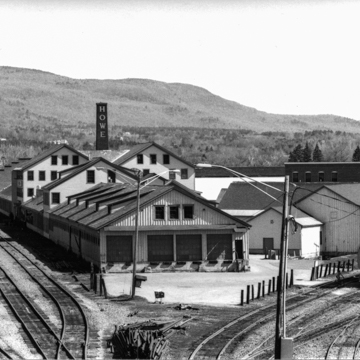You are here
Howe Center (Howe Scale Works)
In 1877 a boiler explosion and fire tore through the Brandon Manufacturing Company, makers of Howe platform and balance scales. These scales, along with those manufactured by the Fairbanks Company in St. Johnsbury, were revolutionizing world commerce by offering affordable and accurate weight-measurement devices for everything from livestock to railroad cars. Company treasurer John Page, also director of the Rutland Railroad and on the board of the Rutland and Bennington Railroad, and George Merrill, superintendent of the Rutland, bought a controlling interest in the company and moved it to a site at the junction of the railroads just south of the depot and rail yards in Rutland village. The buildings erected for the renamed Howe Scale Company were designed by local architect Randall as a V-shaped complex of wood-frame, board-and-batten, “fireproof” buildings, one-story in height with slate roofs, brick interior walls for the casting and foundry areas, brick fire walls separating the manufacturing and storage areas, and on-site hydrants. Shipping and receiving were at the apex of the complex where the two railroads come together just north of the works. The brick company office with a mansard roof and corbeled chimney is a small-scale example of Randall's many Second Empire designs. By 1880 more than 230 workers filled the complex, and Howe Scale was the dominant industrial employer in the city. Several new buildings were added to the complex between 1900 and 1910, when employment reached nearly 800. Foreign competition after World War II led to a slow decline and the works were closed by 1970. Private development revived the buildings in the 1990s as the Howe Center, with mixed office, commercial, and industrial space.
Writing Credits
If SAH Archipedia has been useful to you, please consider supporting it.
SAH Archipedia tells the story of the United States through its buildings, landscapes, and cities. This freely available resource empowers the public with authoritative knowledge that deepens their understanding and appreciation of the built environment. But the Society of Architectural Historians, which created SAH Archipedia with University of Virginia Press, needs your support to maintain the high-caliber research, writing, photography, cartography, editing, design, and programming that make SAH Archipedia a trusted online resource available to all who value the history of place, heritage tourism, and learning.






